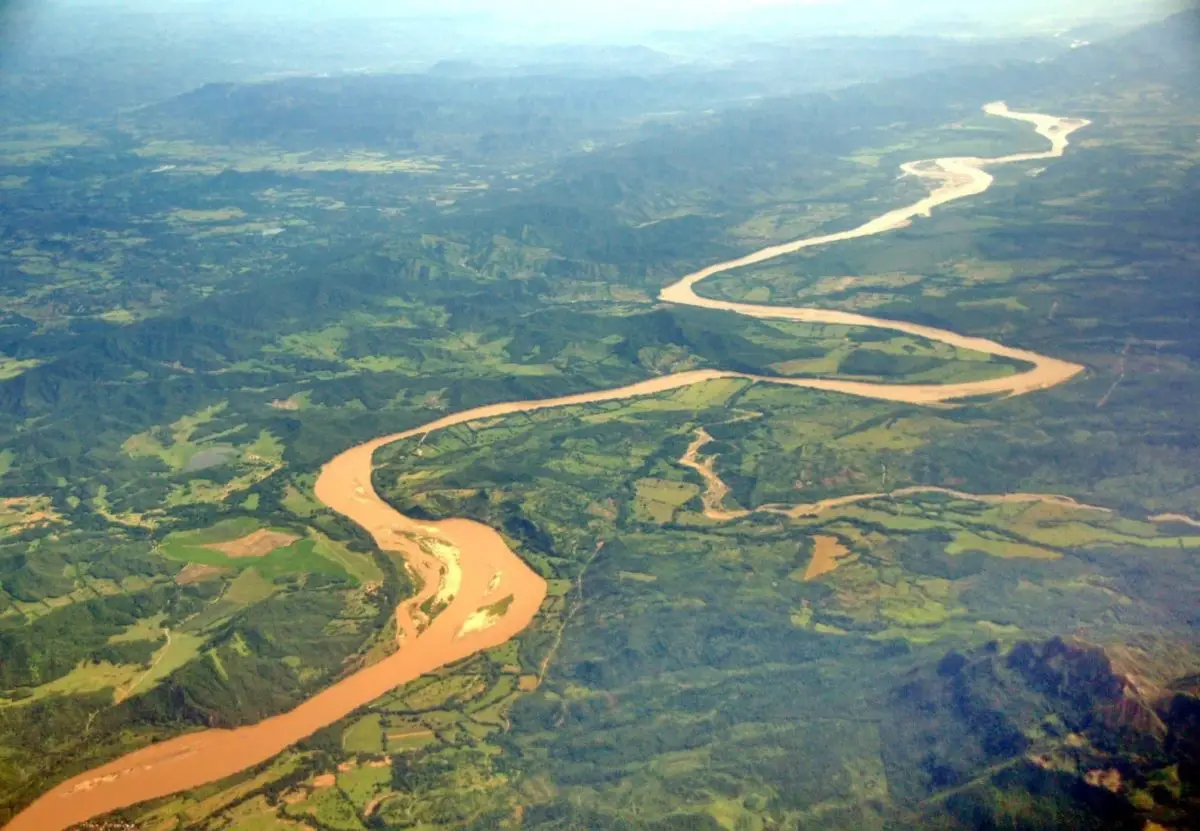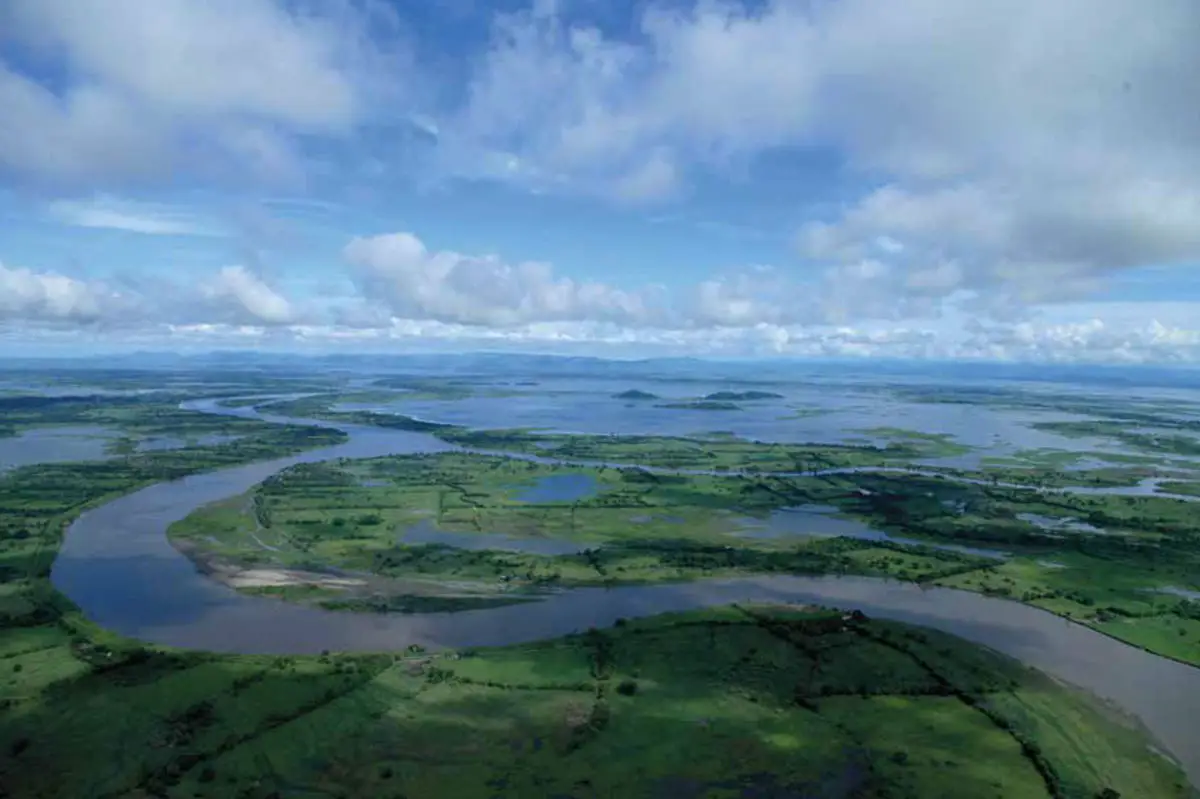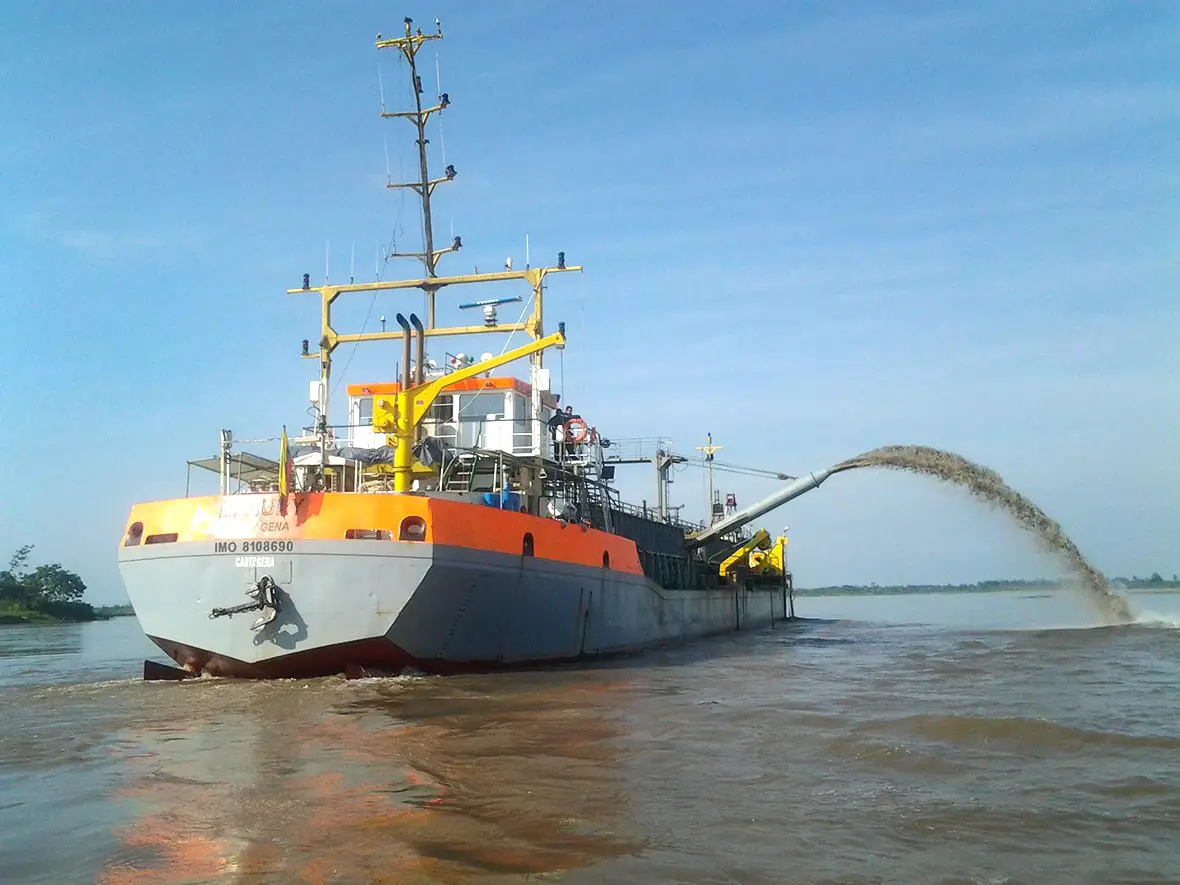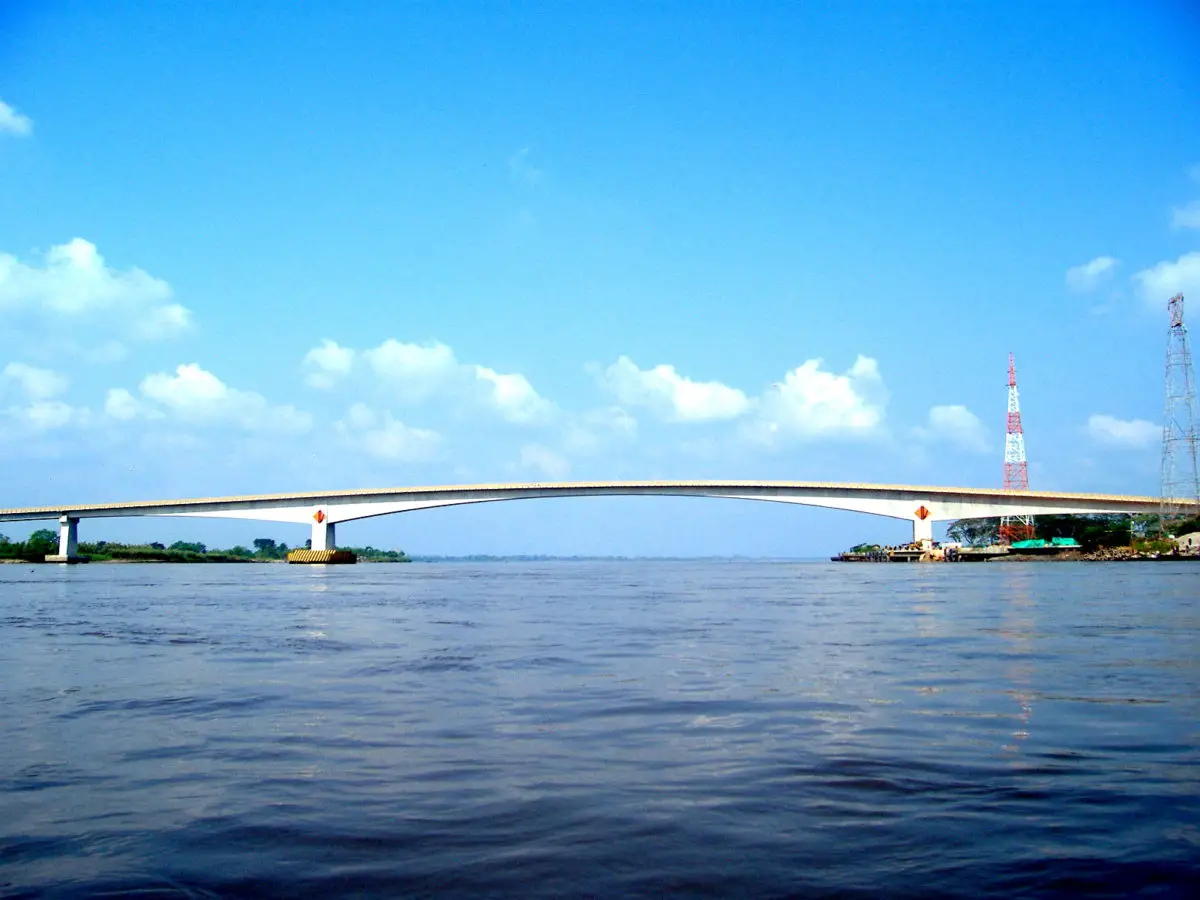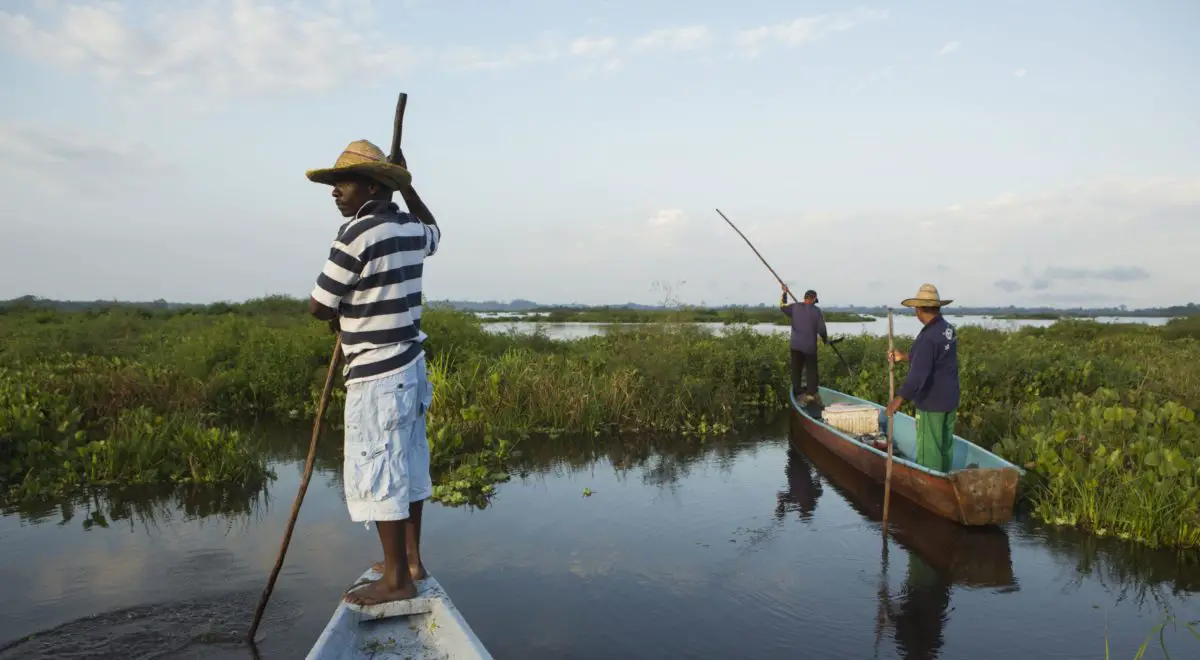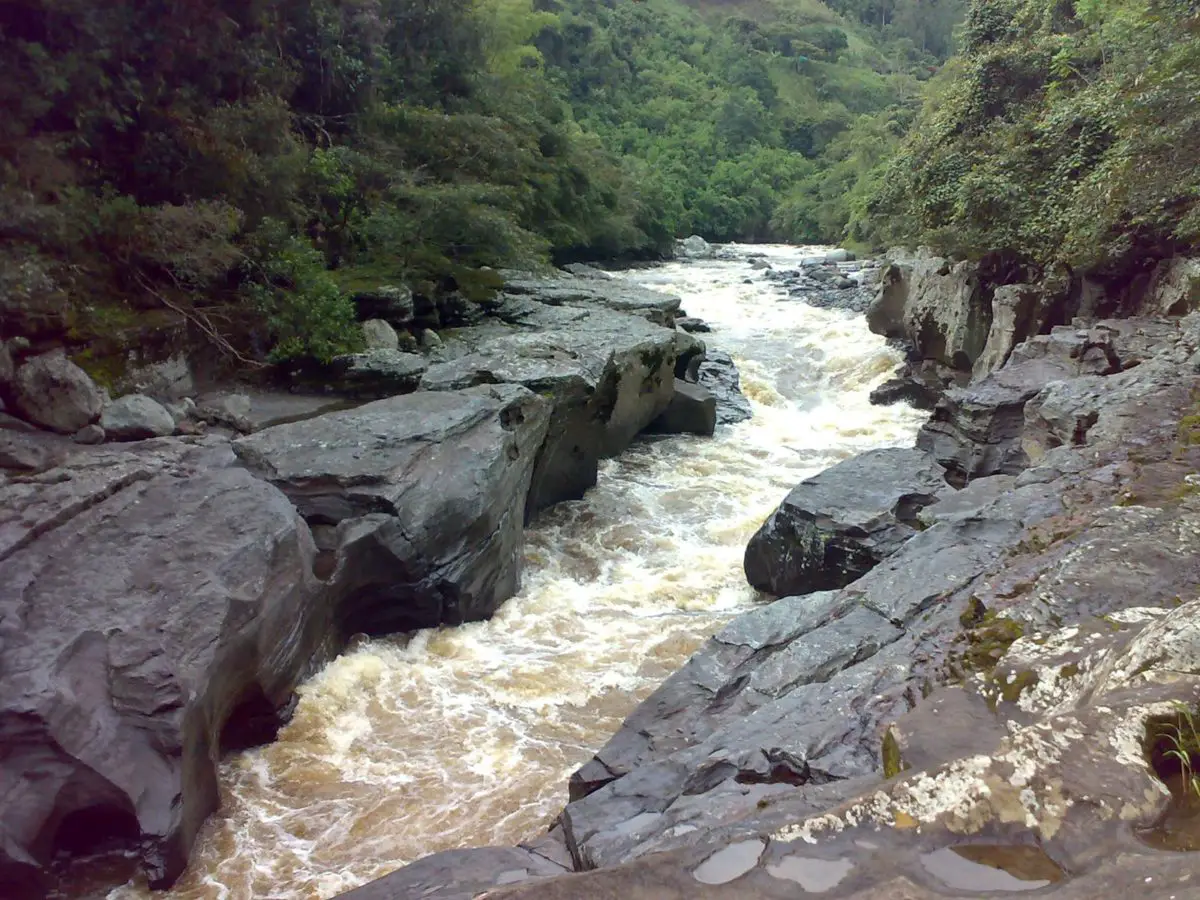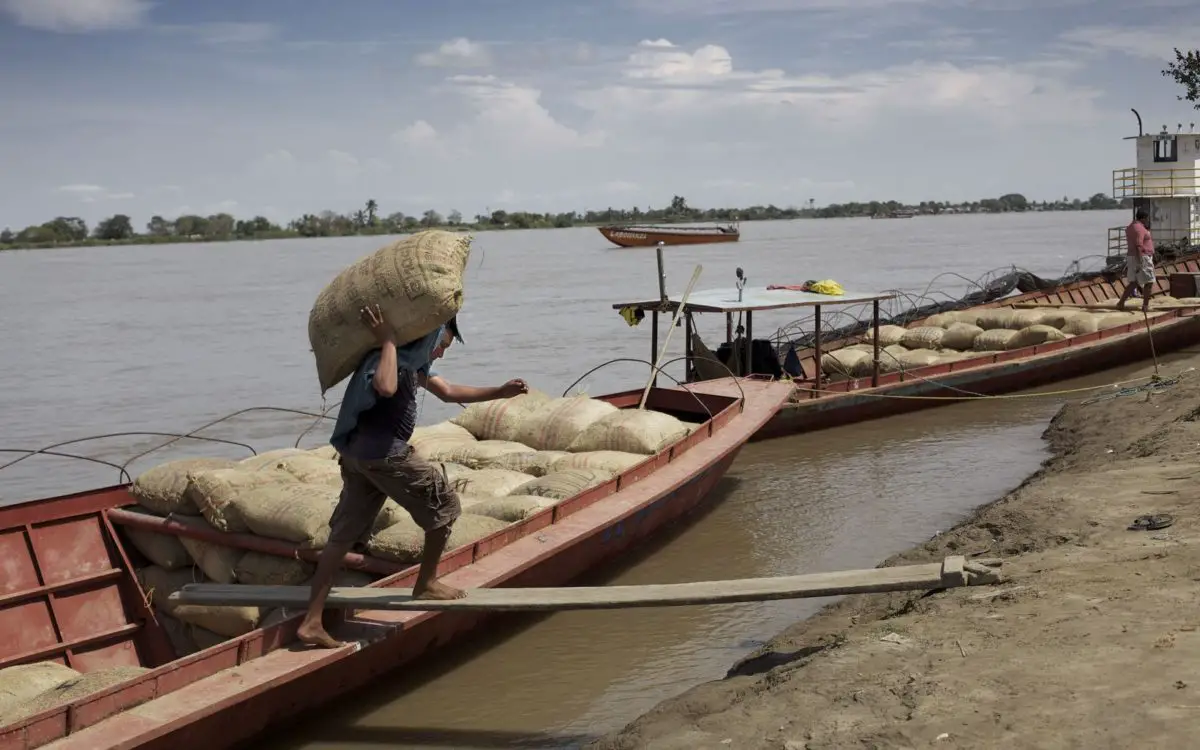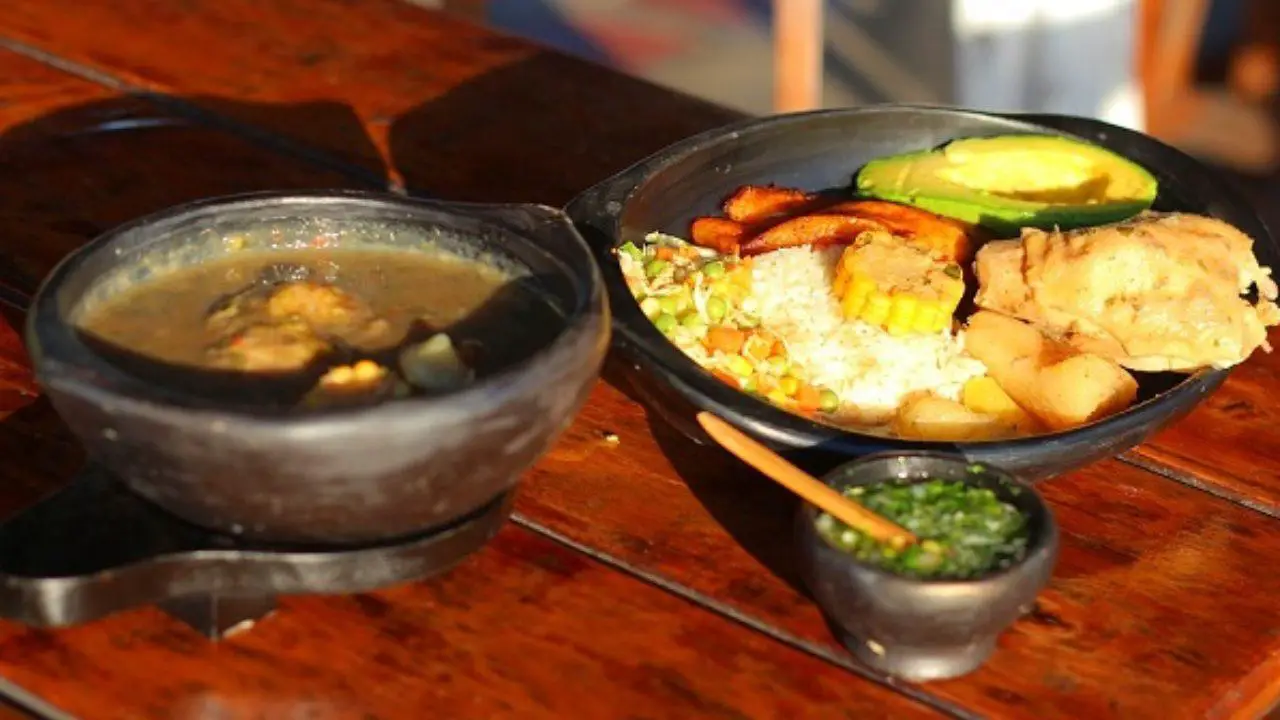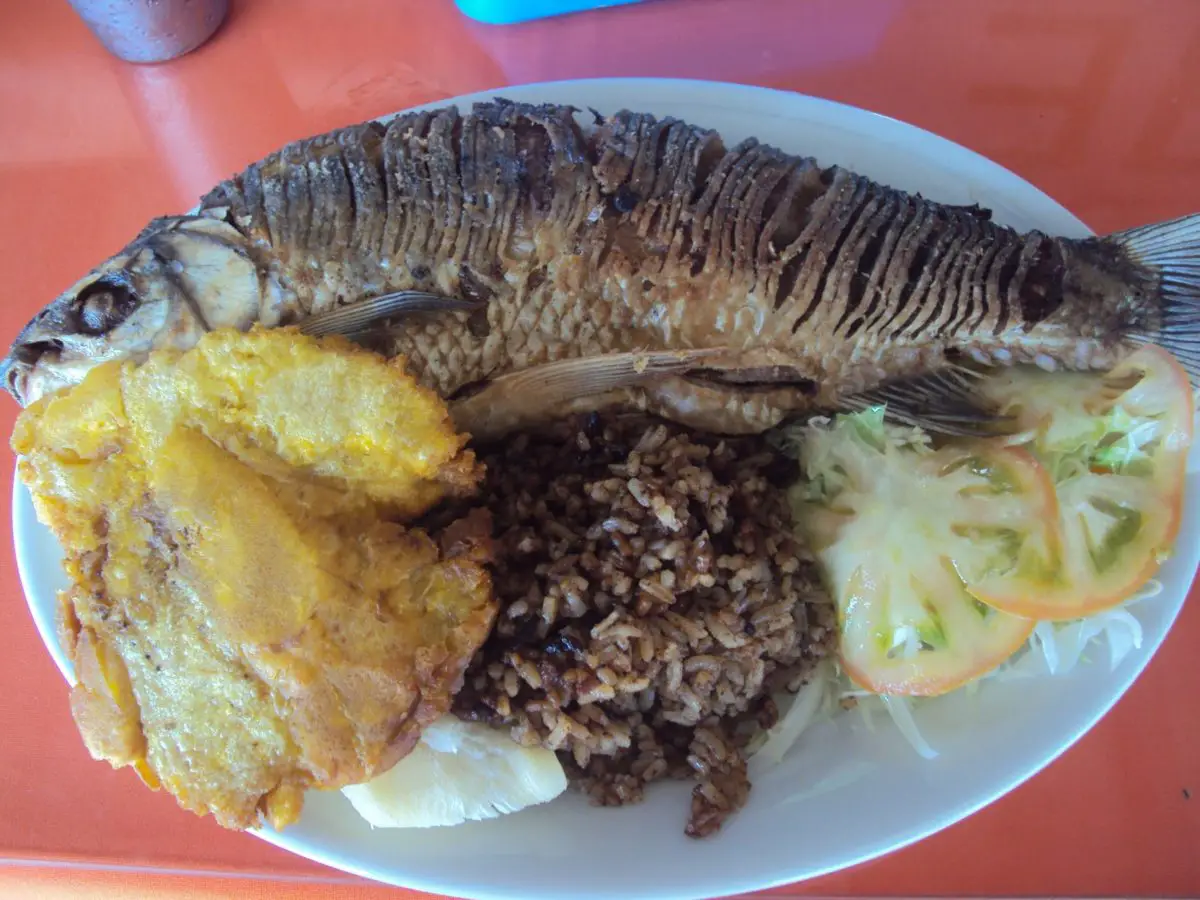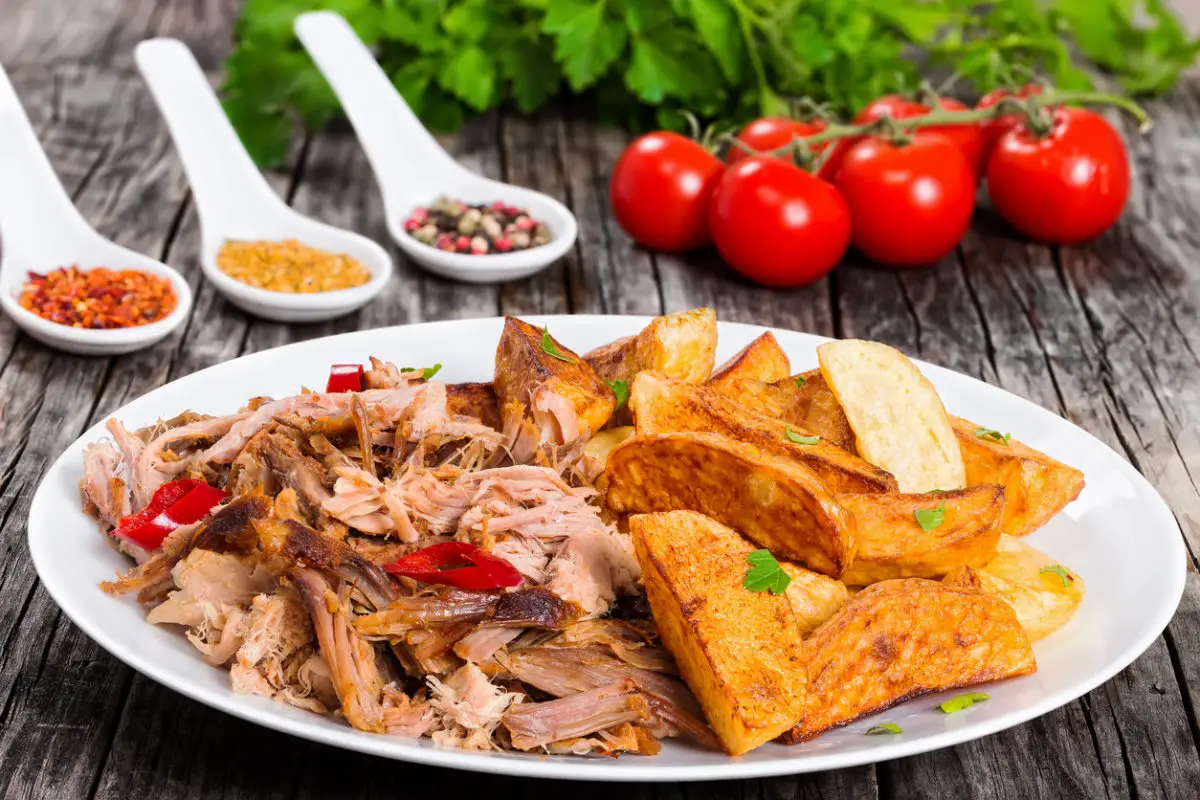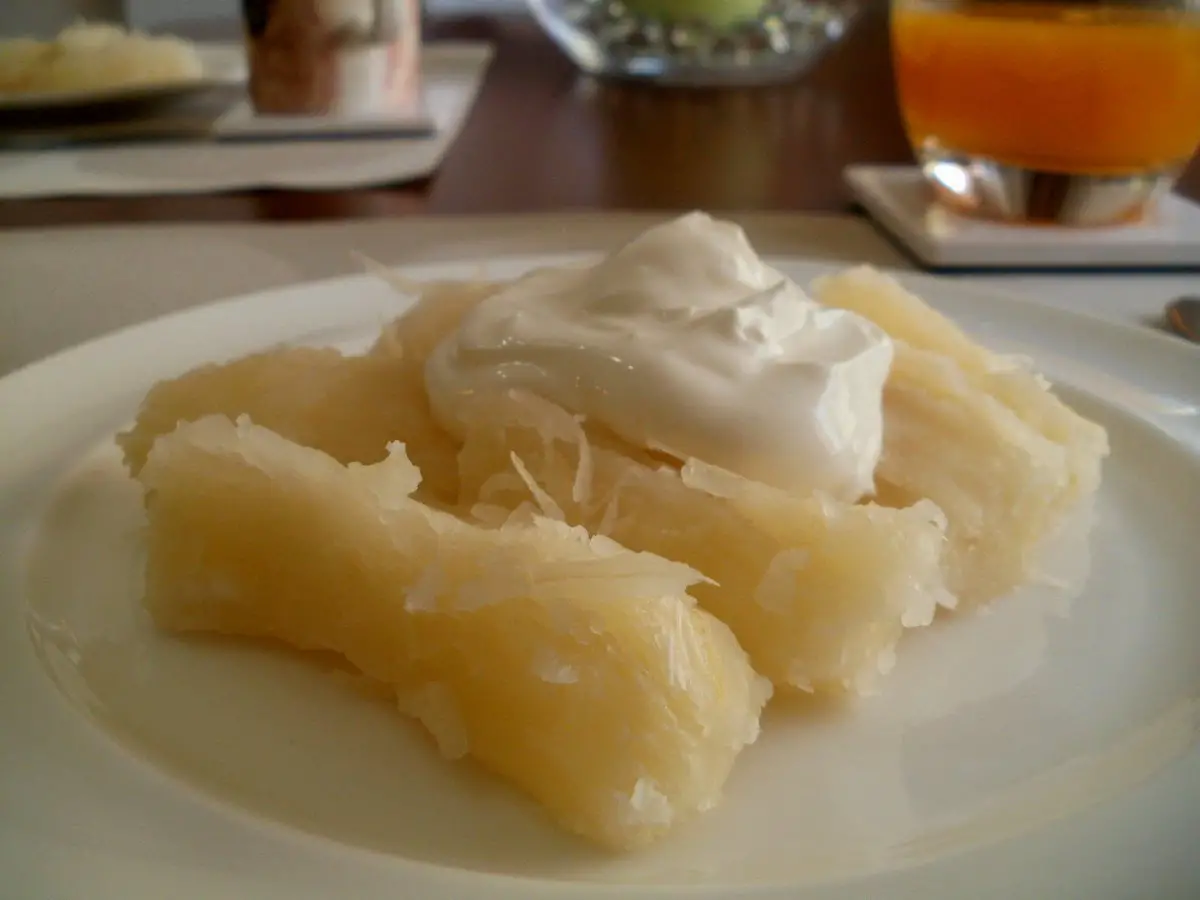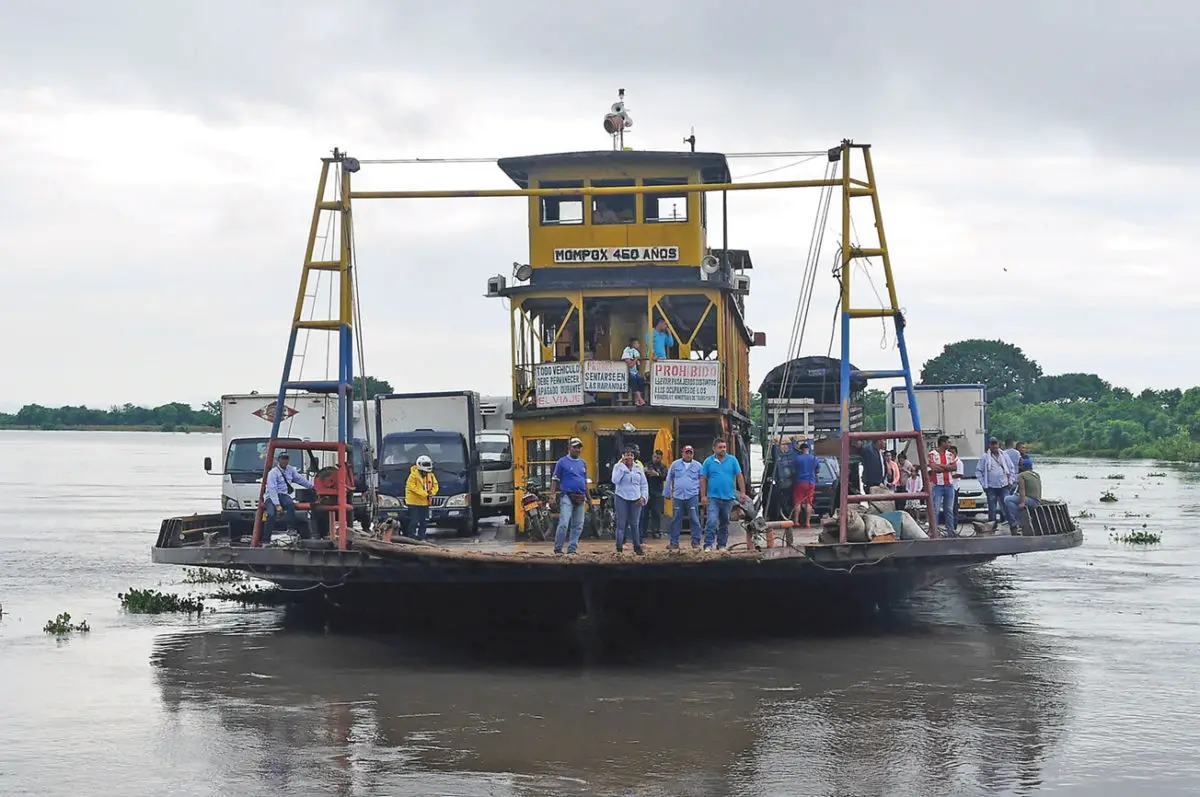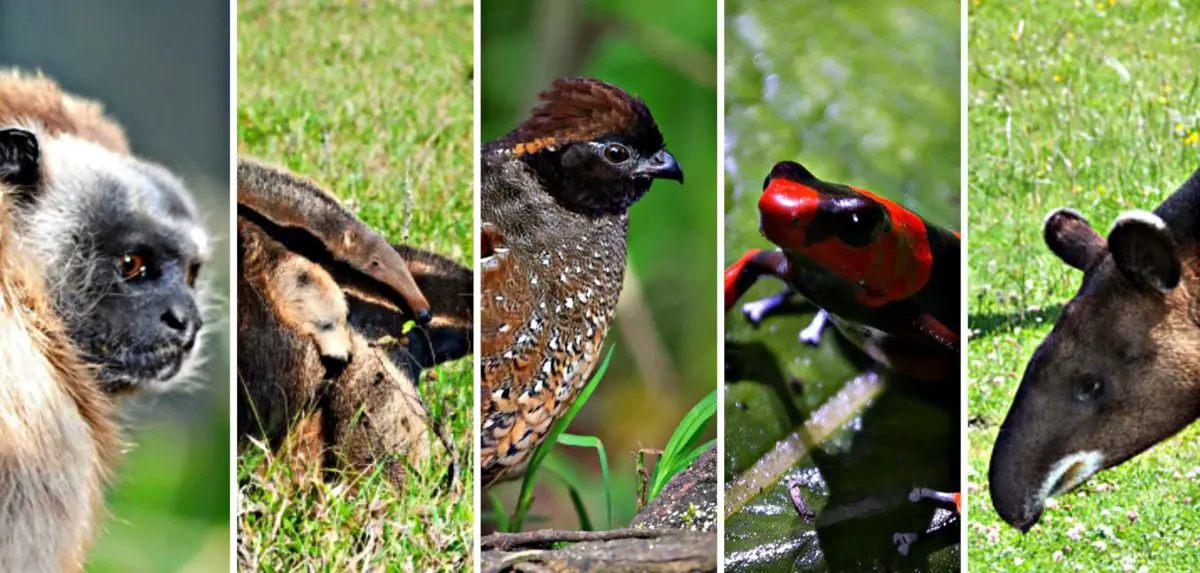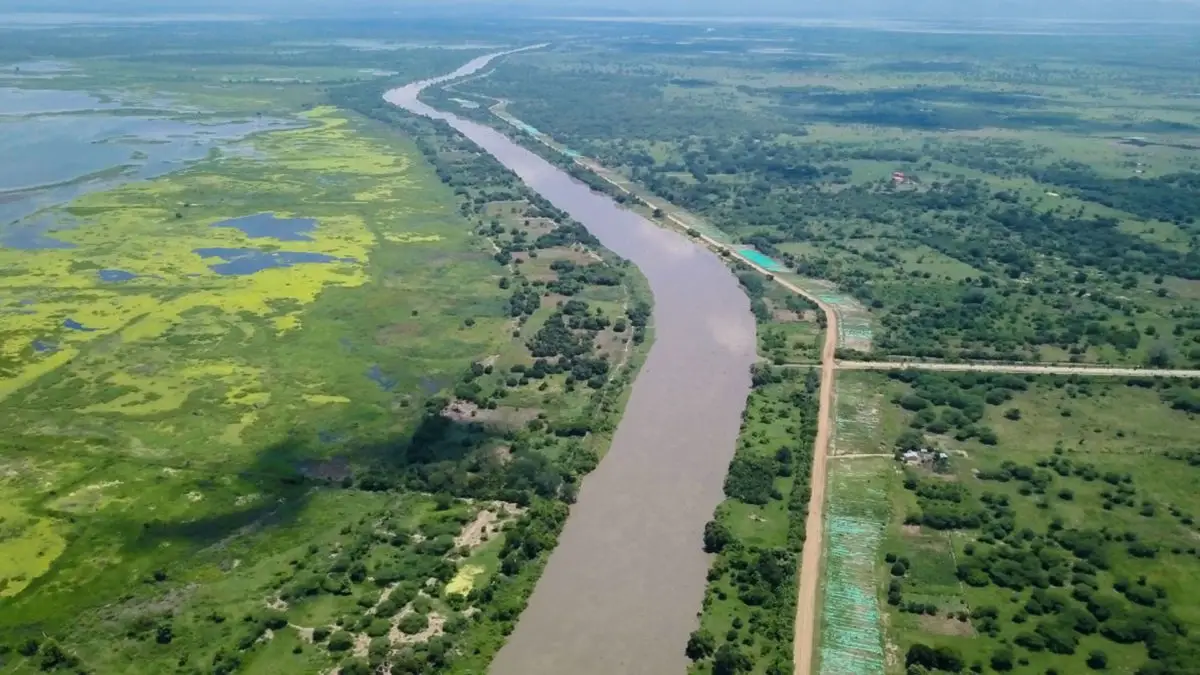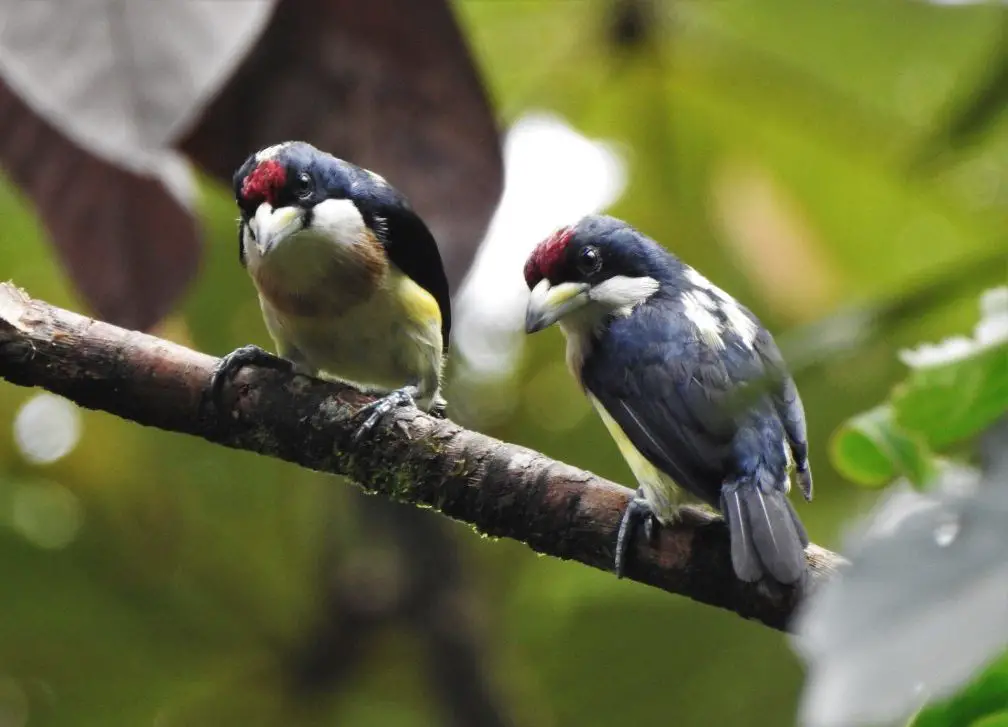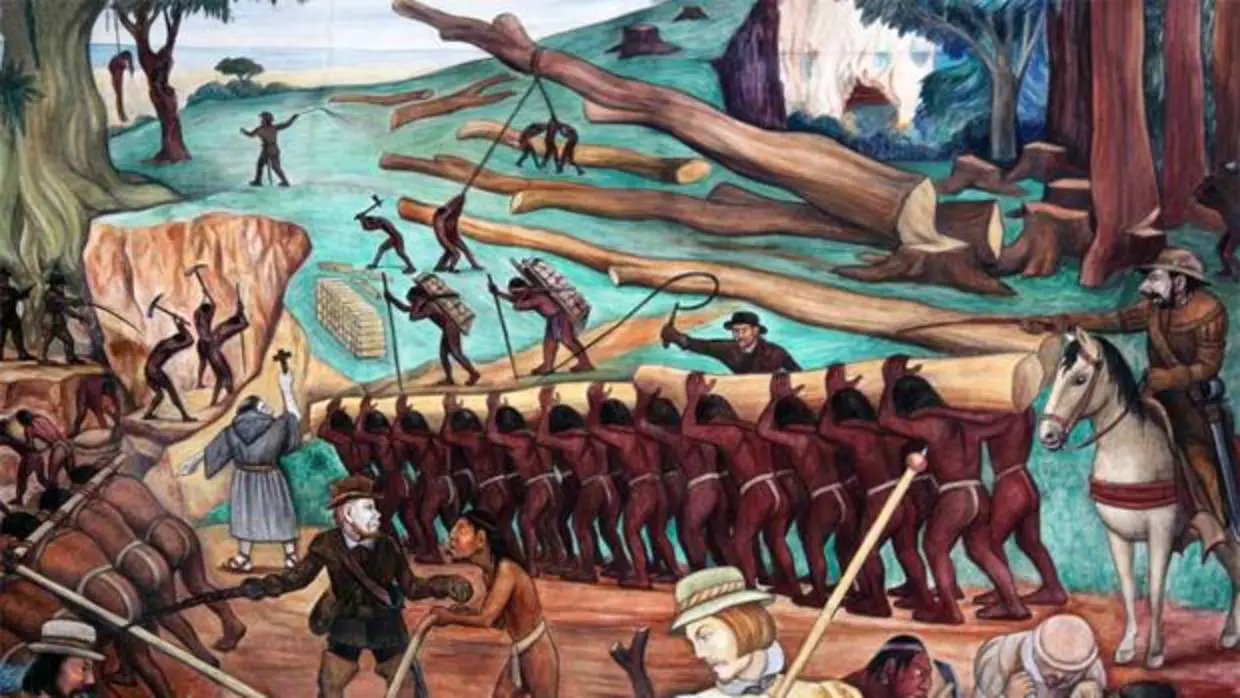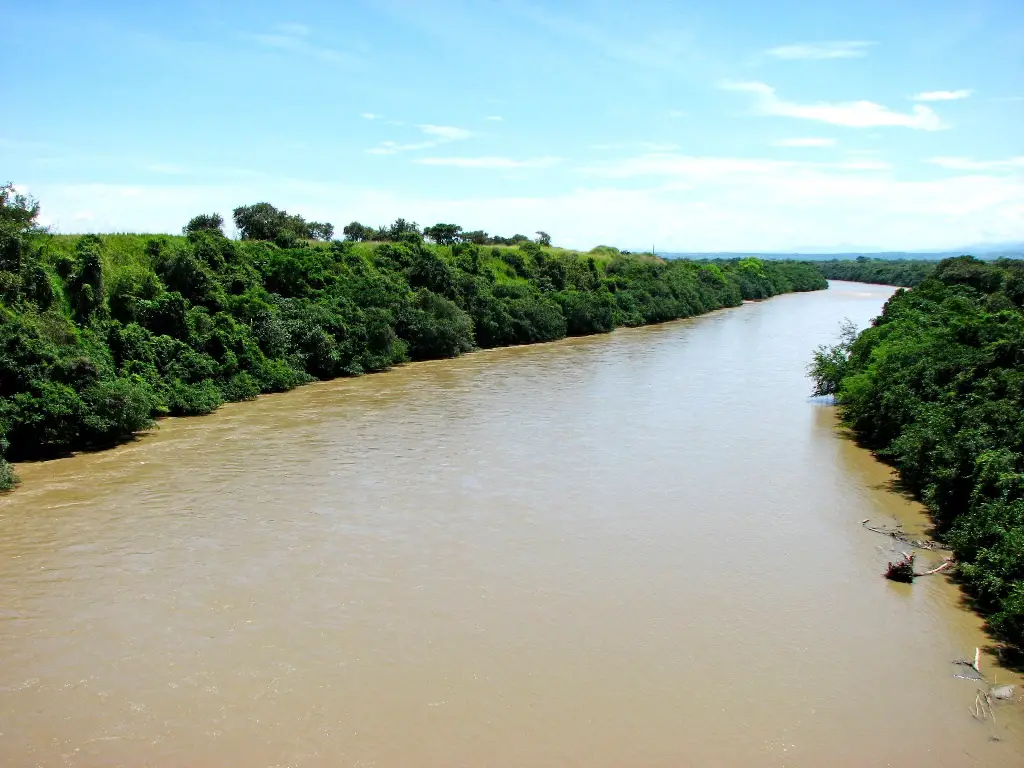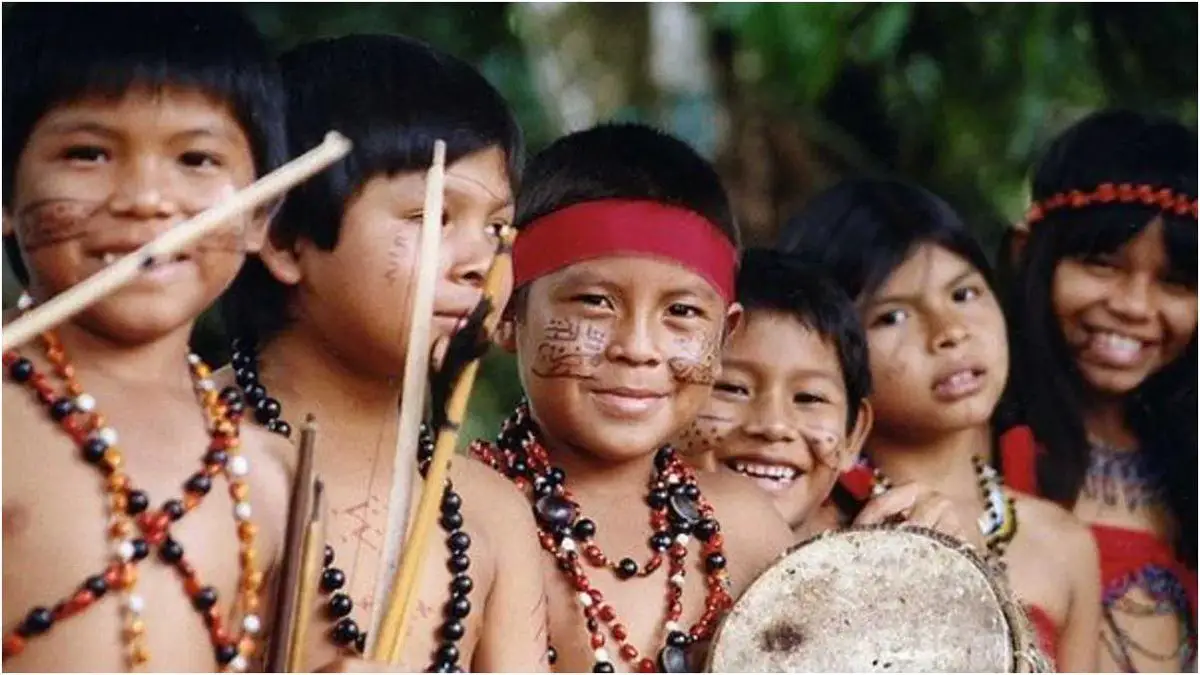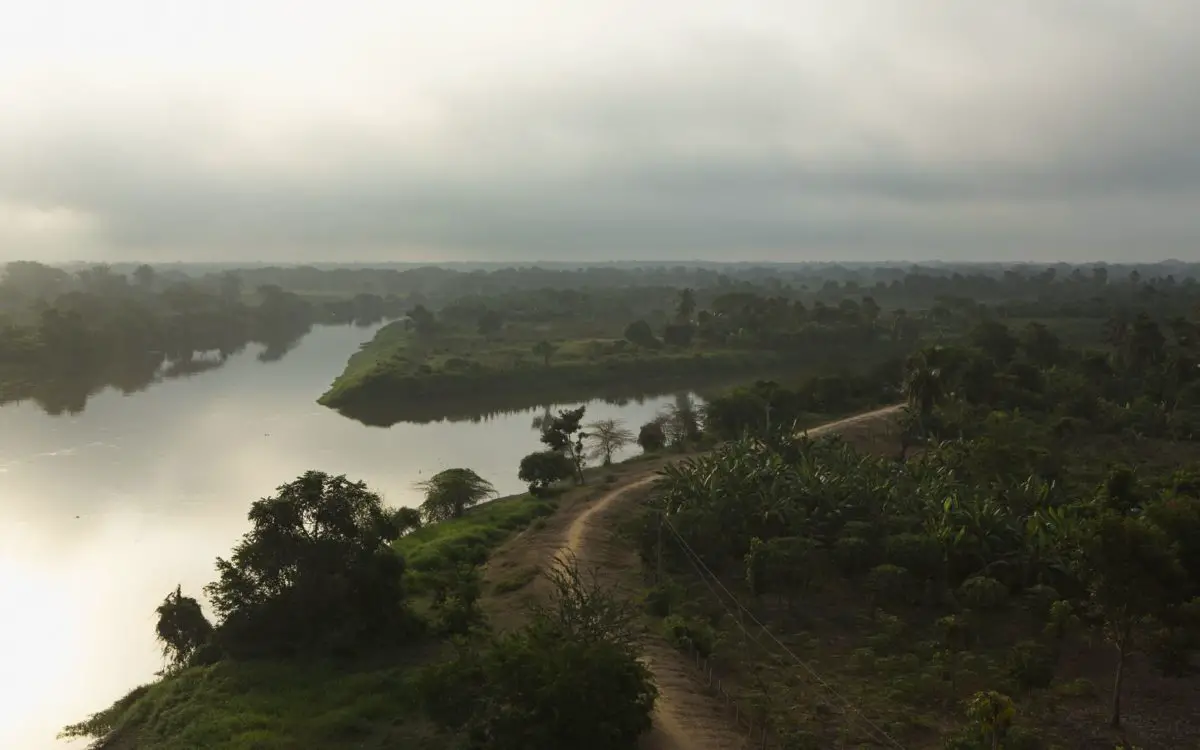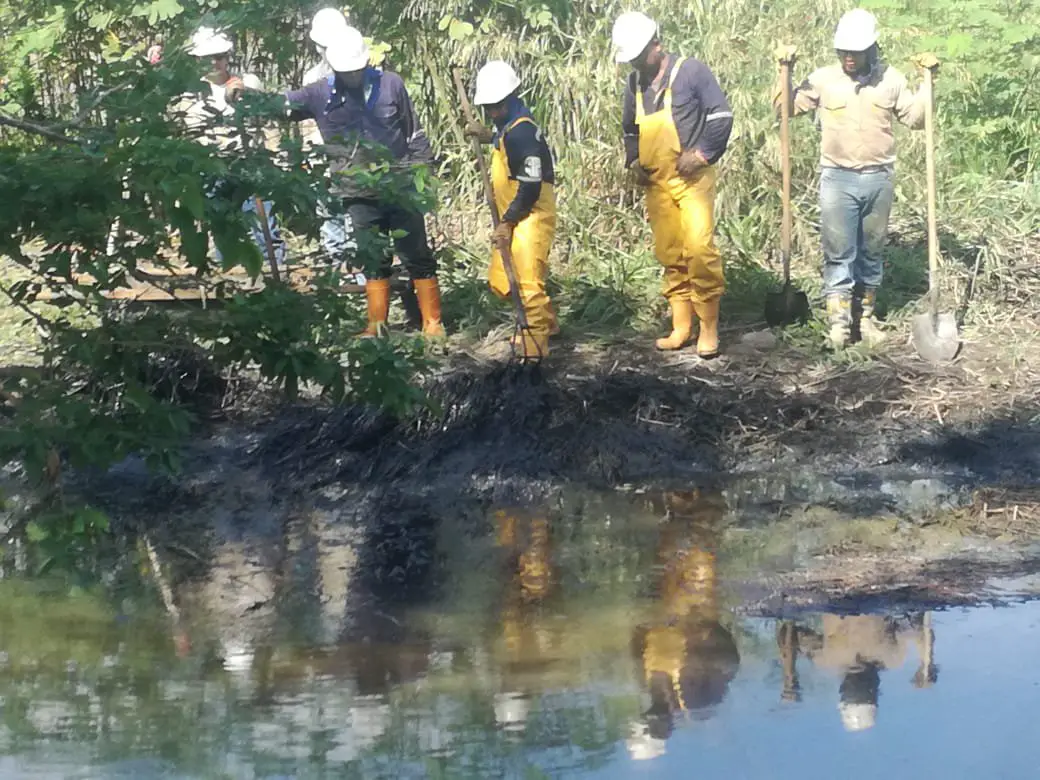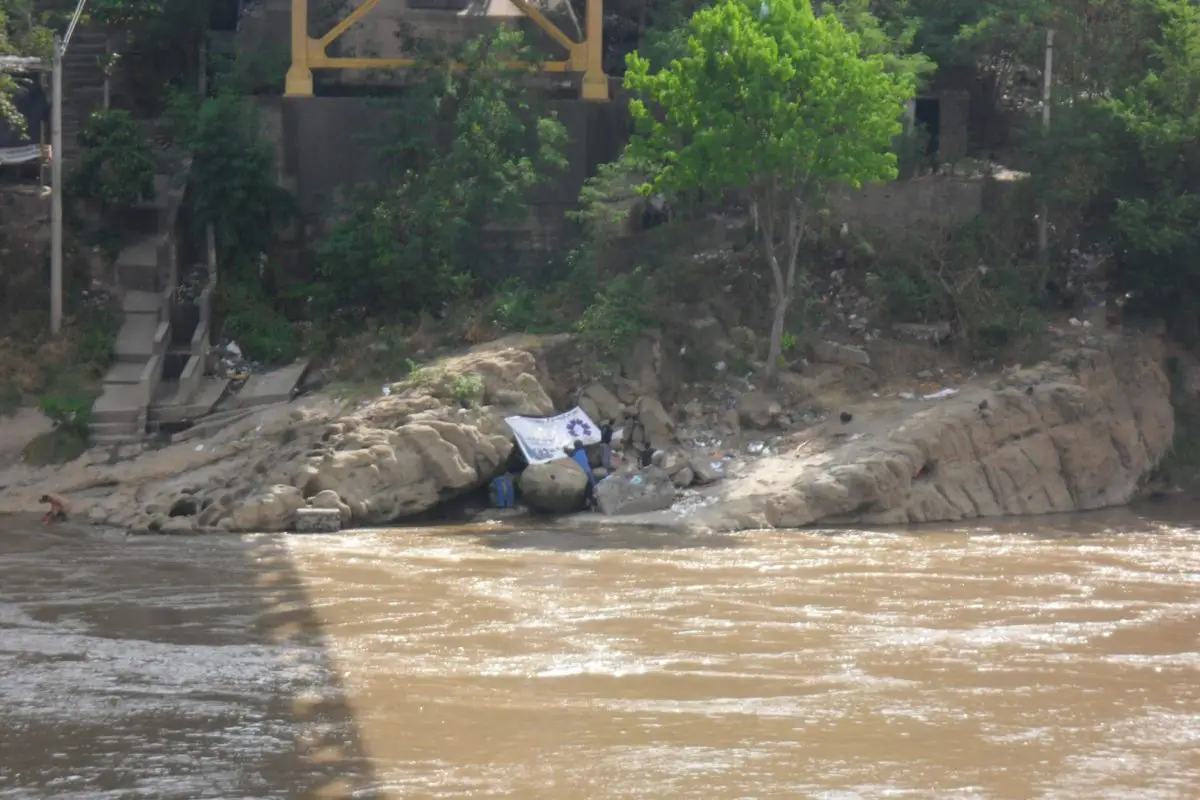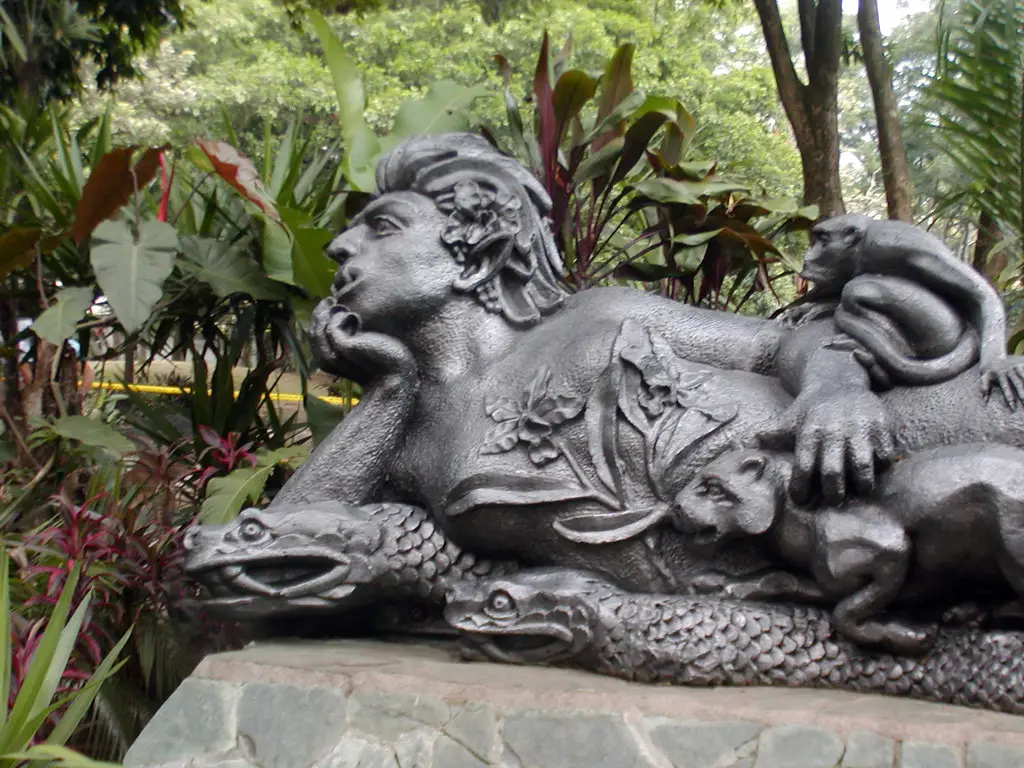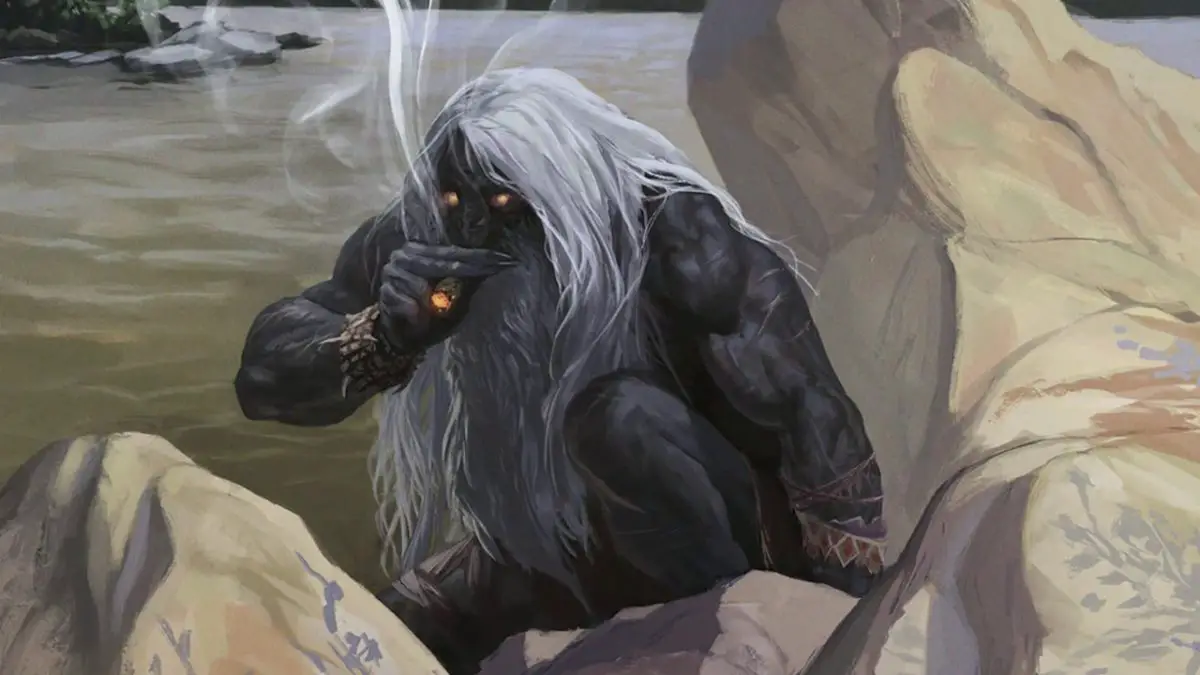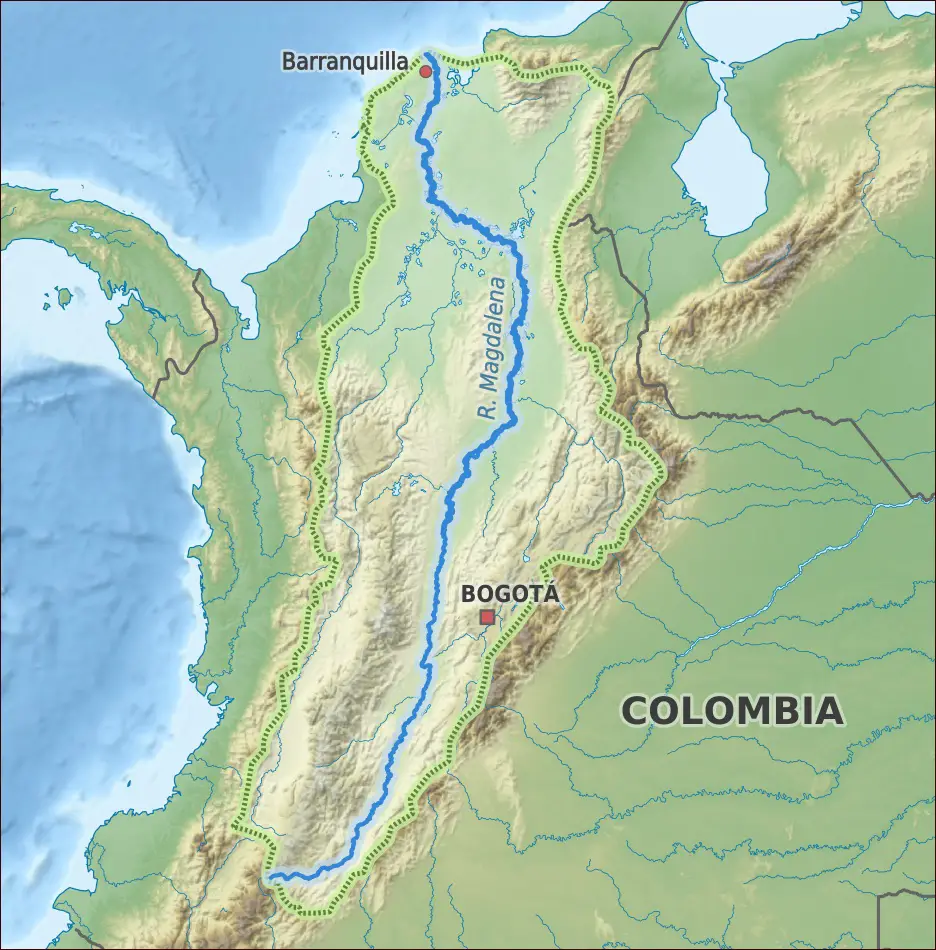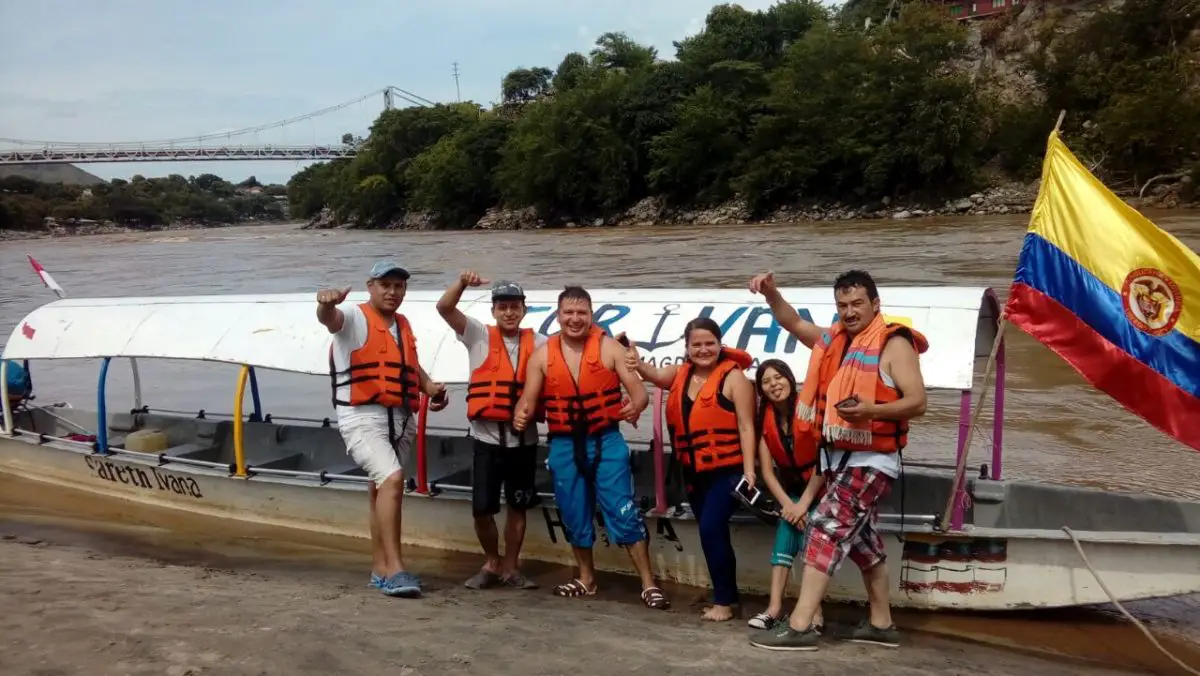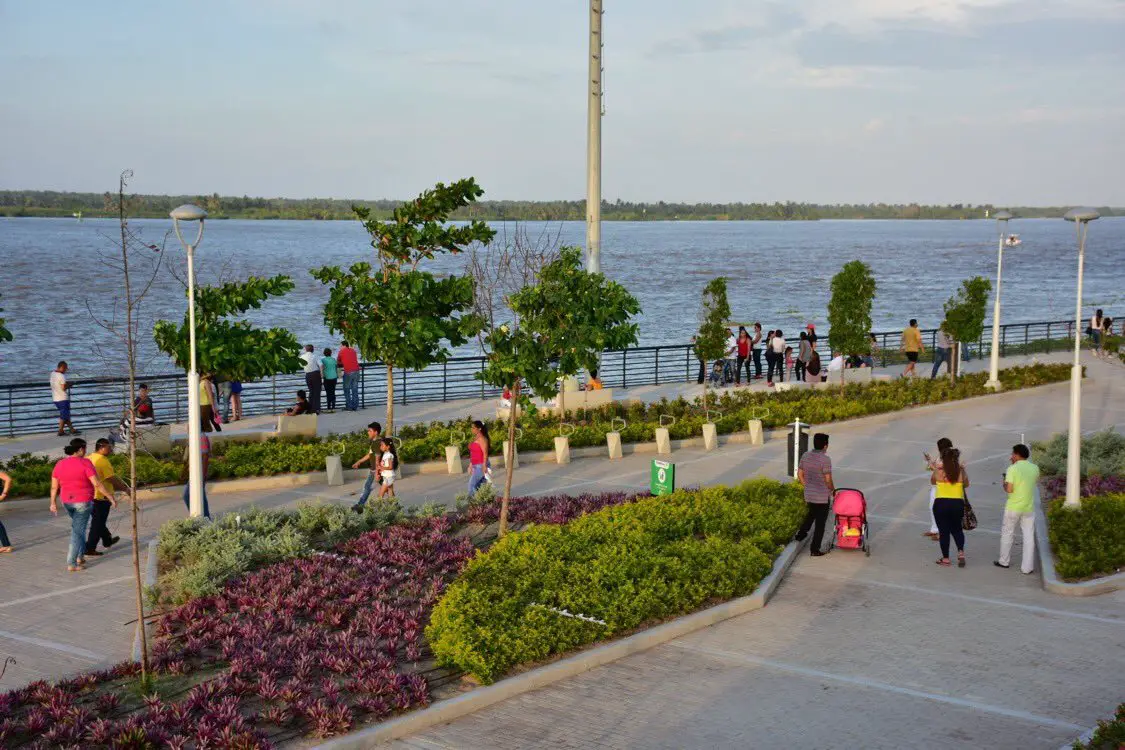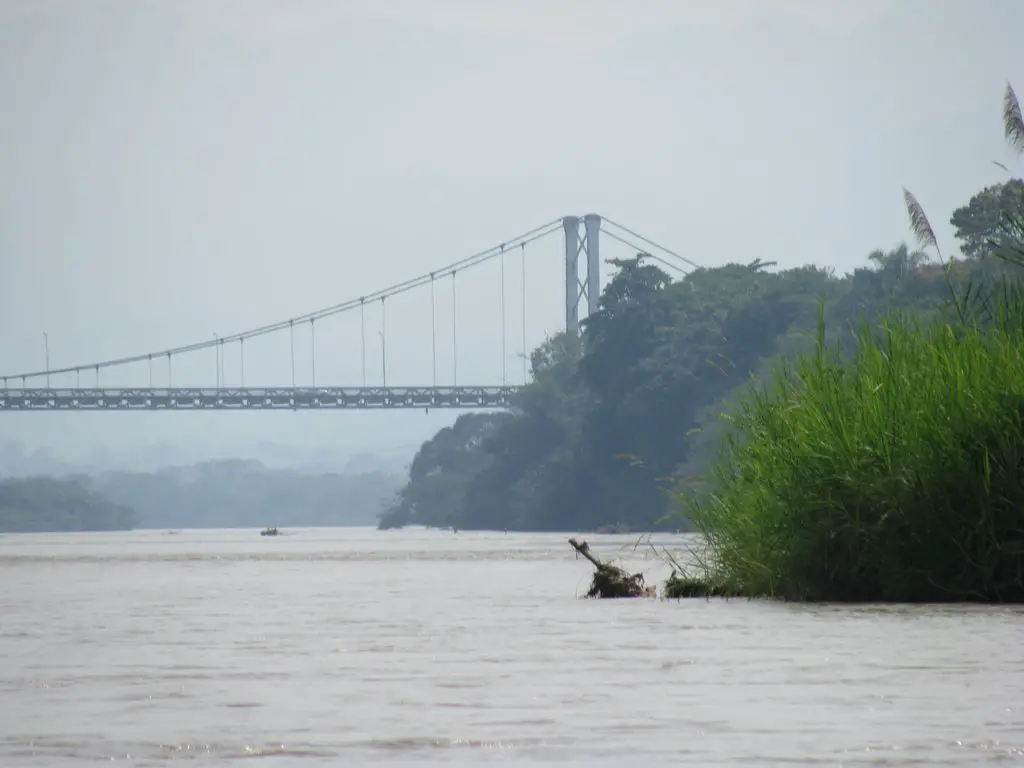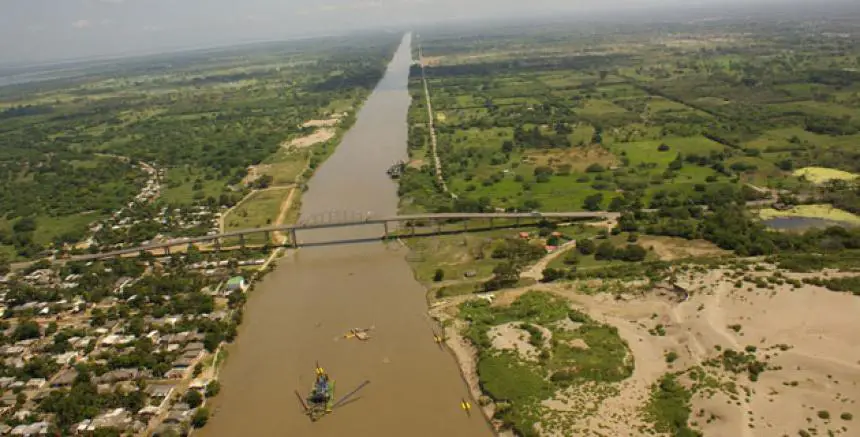Last Updated on August 30, 2023 by Hernan Gimenez
- The Magdalena River, also known as the “Rio Grande”, is located in South America, specifically Colombia, and flows into the Caribbean Sea, with an immense length and tremendous economic and cultural importance in the regions it crosses. If you’re not familiar with it, this is your chance to find out, as it’s our next topic.
Indice De Contenido
- 1 The source of the Magdalena River and its course
- 2 Length, Flow and Altitude
- 3 Valleys and River Basin
- 4 Tributaries of the Magdalena River
- 5 Where does this river flow into?
- 6 Economy and Tourism around the river
- 7 Importance and Influence
- 8 Flora and Fauna of the Grande de la Magdalena River
- 9 History of the Magdalena River
- 10 Environment and Pollution of this important river
- 11 Myths and Legends
- 12 Magdalena River: Map
- 13 Gallery of images
The source of the Magdalena River and its course
The Magdalena River is very important for Colombia, as it has its source in a lagoon of the same name, in a region that is part of the Colombian territory, as part of the Andes mountain range.
It is a hydrological source located in the south-western part of the Paramo of Las Papas, which is about 3,685 metres above sea level, and its waters are discharged into the Caribbean Sea at the height of the region known as Bocas de Ceniza.
Its length is 1,540 kilometres, and along its course it is joined by around 500 rivers and streams. This provides it with a flow that registers an inflow of 6,700 cubic metres per second of time when it flows into the river.
Route
As far as the route of this great Colombian river is concerned, it crosses the departments of Huila and Tolima, but also, on its eastern side, the departments of Cundinamarca, Boyacá, Cesar, Santander and, of course, Magdalena.
On the western side of the river it crosses another part of Tolima, Caldas and Antioquia. Likewise, its regional location has served to establish boundaries between some Colombian departments, such as Cundinamarca, Boyacá, Caldas, Tolima, Antioquia, Bolívar and Atlántico, before flowing into the Caribbean Sea.
Length, Flow and Altitude
These three aspects are fundamental, as their knowledge gives an indication of the great size of the Magdalena River; in this sense, it has a length of 1,540 kilometres and flows through a number of Colombian departments.
In terms of the area of its basin, an average of 257,438 square kilometres has been established, with a flow of 7,200 m³/s, and it is located at an altitude of 3,685 metres, measured at the source of the river.
Valleys and River Basin
It is a river that crosses Colombian territory from the southwest of the Andes to the west, moving from south to north, and along its entire course it has formed valleys and basins, which we will discuss in more detail below.
Valleys
The valleys of the Magdalena River are represented by the departments of Huila and Tolima. They are delimited by their extension from the mouth of the river to the rapids of Honda.
In the region of this river, called Magdalena Medio, there is an open valley that reaches the plains of the Caribbean Sea. In this beautiful valley there are several towns, such as Barrancabermeja, Ibagué and Neiva.
Basin
The basin represented by the Magdalena River hydrographic basin begins in what is known as the Colombian Massif, whose tectonic origin has been determined to be of Tertiary age; the same is true of the Magdalena Valley, also formed by elements of Tertiary age, with some fluvial deposits that have been determined to be of Quaternary age.
Let us remember that the Tertiary period corresponds to the Cenozoic era, one of the divisions of the geological scale that existed more than sixty six million years ago, while the Quaternary period dates from about two million five hundred and fifty years ago to the present day.
The Magdalena River basin covers an area of about 256,622 square kilometres, of which about 990 kilometres are navigable, making it an important river route for Colombia.
Also within the Magdalena River basin, but at a medium level, there is an important hydrocarbon reserve that is being exploited to extract and trade oil as a means of obtaining economic resources for the country.
Its mouth on the Caribbean is in Bocas de Ceniza, 7.5 kilometres from Barranquilla. In this part of the river, one of the most impressive engineering works in the country has been created, which allows large ships to enter through a series of channels that facilitate access to the port.
Tributaries of the Magdalena River
Throughout its course, the Magdalena River is accompanied by numerous tributaries, most of them on its right bank, as in the case of the Lambedulce stream, where the source of the Santiago Lagoon is located about three kilometres away and where rivers such as the Naranjo, Bogotá, Negro, Ermitaño, Mulales and many others originate.
But its main tributary is the Cauca River, the second most important river in Colombia, with a catchment area of 63,300 square kilometres and a length of 1,350 kilometres. This innumerable number of rivers that flow into the Magdalena ensures a good flow of water.
Where does this river flow into?
The Magdalena River has been a primordial scenario for the development of many cultures and peoples, since it has been the main source of water for all the nearby inhabitants, who have also known how to take advantage of its great wealth for their food and trade, making the Magdalena estuary an element of vital importance in the Colombian territory.
Let us not forget that this river empties its waters into the Caribbean Sea at a place called Bocas de Ceniza, 7.5 kilometres from the city of Barranquilla, which has undergone major engineering works to make it more attractive and facilitate access by boat to this area.
An interesting element to highlight is the deviation of the course of the Magdalena River; at the height of the region known as El Banco, there is a deviation of the course towards a region known by the name of Brazo de Loba, which increases the great magnitude of this important river.
It is important to mention that during this deviation of its course in the southern end of the Department of Magdalena, the river flows through regions such as Magangué, but this leads to the city known as Santa Cruz de Mompox, which has a much smaller watercourse. It is worth noting that this town has been a National Monument and World Heritage Site since 1995.
Economy and Tourism around the river
The River Magdalena, like many other rivers in the world, and especially in ancient times, has been an important means of trade, exchange of goods and the exercise of other activities, both for import and export, considered from the point of view of economic sustenance and also for the supply of local commerce.
In this sense, the Magdalena River has been considered a fundamental patrimony for the economic sustenance of the nation, on the one hand because of the use of the surrounding lands, on the other hand because of the fishing carried out in it and, in general, because of the facilities offered by this great river so that it can be used as a means of navigation.
Dams and reservoirs have also been built to take advantage of the river’s great flow, allowing the Colombian state to have a source of electrical energy to meet both domestic and industrial needs, and to use its surplus for exports.
Another aspect worth highlighting is the fact that in recent years the Magdalena River has ceased to be the livelihood of many fishermen and has become the tourist experience of many travellers who come to Colombia to enjoy its beautiful landscapes.
They travel along the Magdalena River and then visit the Tatacoa Desert, which has Villavieja as its entrance road. They will take the opportunity to go fishing in 10-person canoes as soon as the sun rises.
The truth is that the width of this river alone is enough to make tourists feel like they are in a magical world, where they are presented with a contrast of unique colours. You can appreciate the brown water, the green of the riverside trees, the soft yellow sand, the beautiful blue of the sky and the golden, sun-browned skin of the Colombian natives.
Logically, this, together with the energy resources, the fishing and, in general, all the commercial activities carried out with the Magdalena River, allow the Colombian nation to have an element with which to sustain its economy and also to provide the inhabitants of the surrounding areas with a way of earning a living to adequately support their families.
For tourists who come to this great river, there are charming places for all tastes, with places of great beauty, such as Neiva, with its wide promenade, Yondó, the strait of the Magdalena River, a beautiful viewpoint, the promenade of Barranquilla, bridges, reservoirs, large areas for fishing and delicious places to bathe.
Gastronomy
Many tourists consider that one of the characteristic elements of the inhabitants of the Caribbean regions is precisely the fact that they have a wide gastronomy, considered as typical of the coastal areas; on the other hand, represented by delicious dishes, with flavours and spices unique in its style, full of combinations where foods from many indigenous cultures of South America are mixed.
Each region along the Magdalena River has its own special fish dishes, usually accompanied by green guineo or cayeye.
In order to have a broader idea of the dishes that form part of the gastronomy associated with the Magdalena River, we will take as a reference those prepared in some of its most characteristic regions.
Municipality of Ariguaní
This is a more central region, where meat is consumed due to the presence of livestock, so tourists are offered roast pork or stewed meat, in this case with turtle meat, all accompanied by the typical corn flour buns.
Municipality of El Retén
This is a region in the north where the locals have dishes based on the consumption of guineo, known elsewhere as banana or green plantain. In this case, a dish based on this fruit is served with yucca and cheese, commonly known as patacón, usually garnished with mayonnaise and tomato sauce.
At lunchtime, you must try bocachico, a type of fish that can be boiled or fried, but is always accompanied by the typical patacón.
Cienega
This is an area where typical gastronomy is based on products from the sea, such as seafood ceviches, a simple dish made with products such as prawns, oysters, clams, etc., seasoned with spices and eaten raw, simply soaked in lemon juice.
Dish
This is another of the region’s typical towns, where fish is the main ingredient in the cuisine, usually in the form of catfish or mojarra, in whatever form the consumer prefers.
San Antonio Hill
This is a region where the consumption of fish is predominant, especially small species such as shad, viejita, herring and catfish, usually accompanied by bread rolls.
Breakfast usually consists of white rice, beans and fried ripe plantains in the form of slices. But there are also special preparations, such as ponche, a pork dish usually served at the end of the year.
As we can see, if we continue to walk along the Magdalena River, we are sure to find many other dishes that have their traditional roots in these riverside areas and are part of Colombian culture.
Similarly, the gastronomy offers a wide variety of dishes, thanks to which you can taste culinary specialities such as mazamorra de maiz, a good sancocho de gallina made with firewood on the banks of the river, as well as sopa de mondongo or mote de queso.
Visitors to the Magdalena River can try the suero atollabuey with yucca, a corn cob, plantain or yucca bun, some good baked arepas or a morrocoyo or galapago stew. Other dishes include chinchurria with lemon, plantain with cheese and butter, fish widow and other delicacies worth trying.
Minerals
Within the exploitation of the minerals of the Magdalena River, we will mention oil, since it is considered an energetic mineral that has an increasing importance in the country’s economy, and it is extracted from this river, which is why the first concession was granted in the area of De Mares, in the Magdalena Medio. Pipelines transport the fuel to the Atlantic coast, where the first refinery is located in the port of Barrancabermeja.
Coal is also mined in the river basin, and there is considerable mining activity, with nickel, gold and silver mines. These activities are carried out at all levels of production, for small, medium and large industries.
Logically, and this is something that needs to be commented on, this mining activity causes environmental degradation, with known cases of contamination of the waters of the Magdalena River as a result of oil spills, something that has been criticised and controversial on several occasions by the inhabitants of these regions.
While it is true that mining is a form of employment for many families in the area, it is also true that some people engage in clandestine mineral exploitation, which undermines the natural state of the Magdalena River, and environmental awareness needs to be raised in time.
Importance and Influence
The Magdalena River is the largest river in Colombia, with an enormous volume of water and an ideal location that allows it to receive many tributaries along its course, giving this water source greater majesty, which is why it is considered an emblematic element within South America.
If we analyse its tourist and economic development, we can see the importance of the Magdalena River, since it is a great tourist attraction that attracts the attention of numerous travellers who come to discover its charms.
On the other hand, it is also important for the subsistence of the inhabitants of the surrounding areas, as well as for all the living beings represented by the fauna and flora that live thanks to the existence of the Magdalena River.
An interesting element of the river’s location is that it helps to facilitate the movement of people towards the Atlantic Ocean. This is due to the fact that the river practically crosses the Colombian nation from one end to the other.
It is also a source of hydroelectric power, which generates income for both government agencies and private investors. There is also an oil platform in the river, known as Petromag SAS. This is a source of employment for many of the inhabitants of the surrounding regions.
The Magdalena River in the Caribbean region has a dyke channel, which is considered an artificial bifurcation and has its origins in the 16th century, when the Spanish colonists built it to facilitate navigation. This channel is 115 kilometres long and is located in Calamar, and its mouth reaches the Bay of Cartagena.
Flora and Fauna of the Grande de la Magdalena River
The Magdalena River is an environment characterised by great biodiversity, with the presence of numerous animal species, including around 150 species of mammals, more than 600 species of birds, a variety of reptiles with 120 species, another 50 species of amphibians and around 120 species of fish.
If we focus on its flora, we can see that around 4,000 species of vascular plants and ferns have been identified in the regions belonging to this river. This fact is of vital importance, since many of the species found here do not exist anywhere else in the world. For this reason, we will show you some of the representative elements of the flora and fauna of the Magdalena River in the following points.
Fauna of the Magdalena
As for the fauna that is present in the territories surrounding the Magdalena, as well as in its waters, we have:
- Aquatic species such as the Catfish, White Shark, Bocacchico, Zapatero, Mojarra, Salmon, Trout, Carp, Pavón, Tilapia, Catfish, Búrel and Cucha.
- A large number of birds of all colours and sizes, among the most outstanding are The Torito Dorsiblanco, the Carpintero Bonito, the Atrapamoscascas Antioqueño and the Habia Ceniza, among others.
- There are also mammals, such as the grey marmoset, which is an endemic species of this region, the jaguar, the tapir, the tiger, the spiny rat, the Colombian tapir, the sloth, the chiriguo, the panther and many others.
- Reptile species such as the American crocodile, river turtles, boa constrictors, green iguanas, babillas, wheel anoles, among others.
Flora of the Magdalena
The flora along the banks of the Magdalena River is very varied, with a species endemic to Antioquia called Amaphyllon Macriphyllum, as well as trees such as the ymbé, laurel, papo de monte, mamoncillo silvestre, marfil, anones de monte, climbers, palms, ferns, aráceas, orchids and many others.
History of the Magdalena River
The history of the Magdalena River has been written since the beginning of the life of the ethnic groups that inhabited this area, settlements that have been in use since pre-Columbian times, using its waters as a route for their movement and trade with the interior of the country; it was also used as a means of navigation undertaken to travel to Ecuador.
The members of the cultures that arrived in this region of the Magdalena were hunters and gatherers, looking for areas where the climate was less harsh, but where there was flora and fauna to feed their families. Waves of migration followed, mixing races and changing many of the cultural forms that existed at the time.
It was in this spirit that the Spanish set foot on Colombian soil at the beginning of the 16th century, using this river to reach many places that were difficult to access due to their relief. Its discovery was recorded by Rodrigo Bastidas in 1501.
All the cultures that settled in the regions surrounding the Magdalena River, especially the Spanish conquerors, used the basin of this great river as an artery for penetrating into Colombian territories, thus achieving the creation of various settlements on the coasts of the river, exploiting all the mineral and organic resources that were present there.
Another important historical fact is that the river allowed the Iberians to keep in contact with other neighbouring regions, such as Peru and even Mexico, leading to the creation of new trade and travel routes. They founded a salt and emerald capital to take advantage of this new dominion of the Spanish Empire, thanks to the presence of the Muisca people, whose political and social organisation facilitated this type of power.
It is worth mentioning that this river was known as the Caripuña, among other names, by its primitive indigenous inhabitants, and travelling along its course one can see a lush territory, full of natural beauty and a great amount of natural resources, which were very attractive to the conquerors during the colonial period.
With the conquest of the territories of the Magdalena River, Colombia was completely controlled and most of its ethnic groups were subjugated, with the exception of the Karids, who always remained independent, although they were also subjugated over time, resulting in miscegenation and the influence of many diseases coming from Europe.
At the end of all these events, we can say that it is a river that has been known by several names, because in each of its stretches it was baptised in a particular way by the indigenous people, but in time it ceased to be called Caripuña, Huancayo or Karacalí, as it was called Rio Grande de La Magdalena throughout its course. Sadly, over the years it has lost many of its native species, such as caimans, sloths, turtles, manatees and much of its life as a river artery.
Ethnic cultures
This river has been considered a stage in the life of different peoples, such as the Augustinians, who had settlements in the south, or the Quimbayas, who developed in the central mountain range. Among other cultures, the Muiscas, with their Chibcha language, developed the highlands of the Magdalena River and gave rise to the cities of Cundinamarca and Boyacá.
In the Sierra Nevada de Santa Marta, the Taironas developed, considered to be an indigenous and advanced linguistic family compared to others on the continent. Many other ethnic groups also arrived from neighbouring areas, such as the Arawaks from the Amazon and the Urumanguíes from North America.
From the east came the Sálibas and Makus, while some groups that migrated from the Pacific formed the coastal population of Tumaco. At the same time, history records a series of migratory waves that included the Esmeraldas, Gorgona and Catanguero peoples.
All this was accompanied by the invasion of the Caribs, a group of ethnic cultures that influenced the development of life around the Magdalena River during the 8th century.
This was followed by the Spanish conquest in 1492, which was part of the history of the 16th century and led to the establishment of the colony.
Some of the other indigenous groups that made up the ancient territories of the Magdalena River were the Guasanebucanes, Chimilas, Turbacos, Palaguas, Carates, Cimitarras, Calamaríes, Tapajes, Muzos, Pantagoras, Carares and Yareguíes.
Environment and Pollution of this important river
As you know, the Magdalena River is an important source of water for the whole of Colombia, since it crosses eleven departments and 70% of the country’s population lives in its vicinity, which is vital for the country’s economy.
Among other things, its navigability is of vital importance, as is the supply of drinking water for human consumption and the practice of activities such as agriculture, livestock farming, aquaculture and industry, which are indispensable elements of its ecosystem and also the means of subsistence for human life and all the living beings that make up its biota.
However, it is clear that human activity has had a negative impact that has increased over the years, since it has led to the degradation of the soil with the indiscriminate felling of trees and the presence of waste products of human life, as in the case of domestic or industrial practices, which lead to the presence of organic matter, heavy materials and microorganisms that cause contamination of the river.
In addition, the exploitation of hydrocarbons also tends to aggravate the situation, due to the frequent oil spills that pollute the waters of the Magdalena. Other factors include the use of pesticides, herbicides and fungicides to control crop pests, which end up in the river through run-off.
Logically, all these pollutants end up affecting the health of all the living beings that make use of this important body of water, which has been established thanks to the analyses carried out on its sediments, which have shown the presence of a series of heavy metals that accumulate in sedimentary form.
In this regard, it should be noted that in 2016 a toxicological study was carried out on the sediments of the Magdalena River, the results of which indicated the presence of chromium, cobalt, nickel, copper, zinc, arsenic, cadmium, lead and even mercury.
It has been established that all these heavy metals are polluting elements that endanger the lives of the creatures that develop thanks to the water supply provided by this source. For this reason, this type of progressive contamination must be taken seriously and with special attention by the Colombian government authorities.
Myths and Legends
Myths and legends are stories that have been used over the years to explain a series of phenomena that were considered unknown, and at the same time allow the development of certain beliefs based on fear or respect for the natural elements. Many of these stories were used by mothers to make their children change their behaviour, because they instilled fear in them.
In this order of ideas, we can tell you some of the legends associated with the Magdalena River, which are also traditional in Colombian folklore, as we present them below.
Madremonte
Travelling through the lands of Antioquia, one hears stories of a corpulent woman, elegantly dressed, who adorns herself with leaves, mosses and other elements of nature.
She presents herself as the protector of nature, and when she is angry, she makes the fields and cattle full of pests, because she does not tolerate those who usurp the land or hunt the animals. But in this sense she is also a relentless punisher of unfaithful men.
The farmers believe that this madremonte makes the water cloudy for bathing and causes flooding, which is very harmful to everyone.
Mother of Water
This legend is based on stories about a beautiful young woman with blue eyes and golden hair, the daughter of a Spanish conquistador. The young girl suffered the torment of watching her father punish an Indian chief for the gold he had hidden on his land.
The young girl begged her father to release the cacique, with whom she then fled because she had fallen in love with him; but when the father found them, he drowned their son and beheaded the Indian in front of the young girl, who drowned herself in the waters of the Magdalena River in despair.
Over the years, this legend has been passed down from generation to generation, and it is said that the young woman lives under the waters of the river and loves to frighten children and fishermen, whom she causes to drown.
Mohan
This story is told in many of the villages along the banks of the Magdalena River, in areas such as Huila, Calda, Antioquia and Tolima, and is based on a mischievous man who frightens fishermen and takes their fish. This is the Lord and Master of the Waters, a soothsayer who is seen as a dark-skinned, hairy Indian with flashing, treacherous eyes.
It is said that he likes to watch young girls washing their clothes on the banks of the river, and fishermen even claim that he once stole a young girl called Chiquinca and took her to his palace in a backwater of the river, where he has untold treasures and many lighted halls.
A sinister figure with a skull-like face, glowing eyes, a frayed tunic, long hair and a bony body is known as the Weeping Woman, carrying the skeleton of a dead baby in her hands. She leaves behind the terror of her screams and cries, calling for her child who does not wake.
It is a legend that has many versions, but most of them say that she drowned her son on the night of the full moon, and since then she has wandered the area in remorse, because every night she appears to look for him and never finds him.
Many say that she was a fifteen-year-old mulatto woman who, having had this son from a relationship with a lover, killed him to get rid of her sin and now walks the riverside roads looking for him and saying. “Here I threw him out, here I threw him out, where can I find him?
Llorona
A sinister figure with a skull-like face, glowing eyes, a frayed tunic, long hair and a bony body is known as the Weeping Woman, carrying the skeleton of a dead baby in her hands. She leaves behind the terror of her screams and cries, calling for her child who does not wake.
It is a legend that has many versions, but most of them say that she drowned her son on the night of the full moon, and since then she has wandered the area in remorse, because every night she appears to look for him and never finds him.
Many say that she was a fifteen-year-old mulatto woman who, having had this son from a relationship with a lover, killed him to get rid of her sin and now walks the riverside roads looking for him and saying. “Here I threw him out, here I threw him out, where can I find him?
However, this is a legend that varies from region to region, as in the case of the inhabitants of the municipality of Tamalemeque, another version is told, which presents a young woman from a good family who, having become pregnant by her lover without his support, decides to take a potion given to her by a midwife, and later regrets it because there is no way back and she loses the baby. She goes mad and goes to the Caño Tagoto and throws herself into its waters, where she dies.
In addition to these stories, there are many other traditional tales from the regions of the Magdalena River, including the Candileja on a ball of fire, considered to be a soul in pain, which can be seen jumping from samán tree to samán tree at night.
There is also the caiman man, known in the region of El Plato. A story about the life of a fisherman who spied on women and, in order not to be discovered, asked a witch doctor for a potion that would turn him into an alligator, but he was tricked and ended up with an alligator’s body and a human head.
The women no longer bathe where the caiman man used to live and since then he has lived in the regions of El Plato and Bocas de Ceniza, where the fishermen live vigilantly, both in the waters of the river and in its marshes, to hunt this caiman man.
Magdalena River: Map
If we look at the Magdalena River on the map of Colombia, we can see that it rises in the region of the Colombian Massif and flows into Bocas de Ceniza, near the Barranquilla sector, crossing eleven departments along the way. As can be seen in the picture below.
Gallery of images
Finally, we offer you a series of images that will help you appreciate the splendour of this important river in Colombia, as well as the natural resources that are available to everyone who lives near it, including plants, animals and people.
In this picture, a group of tourists is about to embark on an adventure on the Magdalena River. Every day, many of these small boats set sail from different points along the river to provide visitors with an unforgettable experience. This is an image of the Gran Malecon on the Magdalena River in Barranquilla. A structure of long walkways along which the inhabitants of this city and its visitors can recreate themselves doing all kinds of outdoor activities with the majestic view of the Rio Grande. This image shows a view of the bridge over the Magdalena River, which connects Barranquilla with the island of Salamanca and other regions of the country through the Ciénaga. This image shows a view of the bridge over the Magdalena River, which connects Barranquilla with the island of Salamanca and other regions of the country through the Ciénaga. If you liked the information contained in this article, we invite you to continue learning about other rivers in Colombia through the following links:

